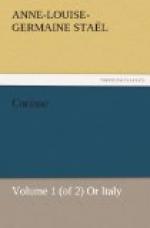Advancing towards the modern Capitol, we see to the right and to the left two churches, built on the ruins of the temples of the Feretrian and Capitoline Jupiter. Before the vestibule is a fountain, over which preside two rivers, the Nile and the Tiber, with the she-wolf of Romulus. The name of the Tiber is not pronounced like that of inglorious rivers; it is one of the pleasures of the Romans, to say, “Conduct me to the borders of the Tiber; let us cross the Tiber.” In pronouncing these words they seem to invoke history and to re-animate the dead. In going to the Capitol, by way of the Forum, we find, to the right, the Mamertine prisons.—These prisons were at first constructed by Ancus Martius, and were then employed for ordinary criminals. But Servius Tullius caused more horrid ones to be dug under ground for state criminals, as if such prisoners were not those who deserve most consideration, since their errors might be united with sincerity. Jugurtha and the accomplices of Cataline perished in these prisons. It is also said that St Peter and St Paul have been incarcerated in them. On the other side of the Capitol is the Tarpeian Rock, and at the foot of this rock we find at the present time a hospital, called The Hospital of Consolation. It seems that thus in Rome the severe spirit of antiquity and the mildness of Christianity meet each other throughout the ages, and present themselves to our sight as well as to our reflection.
When Oswald and Corinne had reached the top of the tower of the Capitol, she showed him the Seven Hills; the city of Rome bounded at first by Mount Palatine, then by the walls of Servius Tullius, which enclose the Seven Hills; lastly by the walls of Aurelian, which still serve as an enclosure to the greatest part of Rome. Corinne recalled to mind the verses of Tibullus and Propertius[12], who are proud of the weak beginnings whence has sprung the mistress of the world. Mount Palatine was in itself the whole of Rome for some time, but afterwards the palace of the Emperors filled the space which had before sufficed for a nation. A poet, in the time of Nero, made the following epigram upon this occasion.[13] Rome will soon be only a palace. Go to Veii Romans, if this palace does not now occupy Veii itself.
The Seven Hills are infinitely less elevated than formerly when they deserved the name of the Steep Mountains. Modern Rome is raised forty feet above the ancient city. The valleys which separated the hills are almost filled up by time with the ruins of edifices; but what is more singular yet, a heap of broken vases has raised two new hills;[14] and we almost discover an image of modern times, in this progress, or rather this wreck of civilisation, levelling mountains with valleys, effacing in the moral as well as the physical world all those beautiful inequalities produced by nature.
Three other hills,[15] not comprised in the seven famous ones, give something picturesque to the city of Rome, which perhaps is the only city that of itself, and in its own boundaries, offers the most magnificent points of observation. It presents such a remarkable mixture of ruins, edifices, fields and deserts, that we may contemplate Rome on all sides, and always find a striking picture in the opposite perspective.




